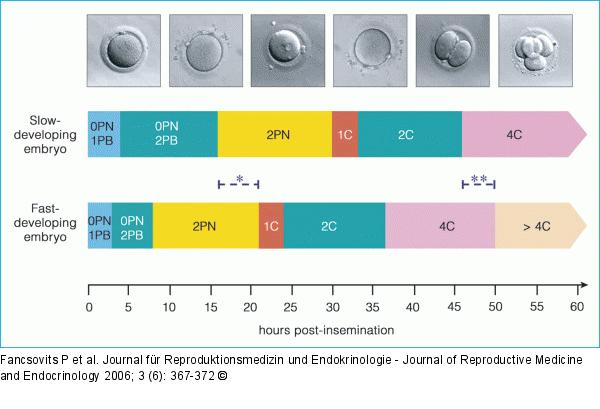Fancsovits P, Takacs FZ, Tothne GZ, Papp Z, Urbancsek J Examination of Early Cleavage an its Importance in IVF Treatment Journal für Reproduktionsmedizin und Endokrinologie - Journal of Reproductive Medicine and Endocrinology 2006; 3 (6): 367-372 Volltext (PDF) Summary Übersicht
| ||||
Abbildung 2: Slow-cleaving - Fast-cleaving Comparison of the development of slow- and fast-cleaving embryos from fertilisation to the 4-cell stage. Pronuclear breakdown and first cleavage occur earlier in faster-developing embryos than in those with slow development. The time-span between the development of faster- and slower-developing embryos can be up to 8–12 hours. It can easily occur that faster- and slower-developing embryos have the same number of blastomeres at the time of morphological assessment performed before embryo transfer. 0PN = no pronucleus; 2PN = two pronuclei; 1PB = one polar body; 2PB = two polar bodies; 1C, 2C, 4C = 1-, 2- and 4-cell stage of the embryo; *Too early assessment of pronuclear breakdown does not help to distinguish early- and late-developing embryos. **Morphological assessment in the indicated period does not allow differentiation of early- and late-developing embryos. Assessment of early pronuclear breakdown or early cleavage can help to determine viability in case of embryos with similar morphological characteristics. [Author permission granted by P. Fancsovits]. |

Abbildung 2: Slow-cleaving - Fast-cleaving
Comparison of the development of slow- and fast-cleaving embryos from fertilisation to the 4-cell stage. Pronuclear breakdown and first cleavage occur earlier in faster-developing embryos than in those with slow development. The time-span between the development of faster- and slower-developing embryos can be up to 8–12 hours. It can easily occur that faster- and slower-developing embryos have the same number of blastomeres at the time of morphological assessment performed before embryo transfer. 0PN = no pronucleus; 2PN = two pronuclei; 1PB = one polar body; 2PB = two polar bodies; 1C, 2C, 4C = 1-, 2- and 4-cell stage of the embryo; *Too early assessment of pronuclear breakdown does not help to distinguish early- and late-developing embryos. **Morphological assessment in the indicated period does not allow differentiation of early- and late-developing embryos. Assessment of early pronuclear breakdown or early cleavage can help to determine viability in case of embryos with similar morphological characteristics. [Author permission granted by P. Fancsovits]. |


